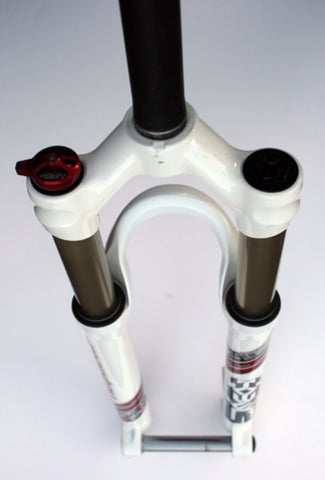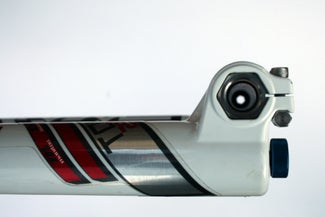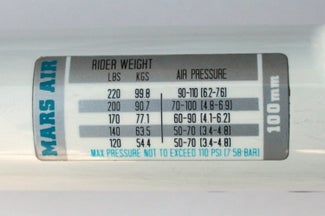
With a history that dates back twenty years, Manitou’s Tower Pro marks a welcome return to form from one of the oldest brands in mountain biking.
Headlining the companies 29er cross country fork line the Tower range replaces the older Minute line.
There are two forks – the Tower Pro and the cheaper Expert – the main difference being in the spring system. The Expert gets the ACT Air system while the Pro gets the superior MARS Air system along with a lighter crown and butted legs that result in a lighter fork. On test here is the Tower Pro.
Out of the box it is a distinctive looking fork. The reverse break arch looks really good, and yes, the fork is more than stiff enough.

It also comes in a 20mm thru-axle option, the version reviewed here, more commonly found on long-travel bikes.
This seems a little overkill. I wonder would the 9mm version have suited me better (I weigh about 155 pounds) although for heavier riders this is definitely an attractive option.
Manitou are also thankfully producing a 15mm quick release adapter which will make the fork more upgradable as you may not need to change your wheel package. This is a big bonus as the 20mm system requires five bolts to be loosened to remove the wheel, a bit of a drag if you are a racer and nowhere near as quick as the offerings from its main competitors.

The graphics leave something to be desired and are more in tune with a dirt-jump fork. That being said, they are easily removable and I suppose this allows you to customize it to your taste – either the more conservative stripes or the more aggressive TOWER graphic. Personally I am for the former.
Back to the spring system. Here is where the fork really differentiates itself.

The MARS Air system incorporates a coil spring and an air cartridge, a highly unusual combination in a cross country fork yet the result is very smooth travel that performs really well. The air cartridge comes into play at the latter half of the travel to ramp things up nicely and springs can be changed to match rider weights.
As someone used to riding mainly air sprung forks it was a bit of a revelation, if a little bouncy at first, but I soon adapted. Perhaps here is where the 20mm axle proves itself as the extra bounciness doesn’t result in tracking problems under side loading in corners.
Damping is provided by Manitou’s TPC+ platform which has independent compression and rebound adjusters at the top and bottom of the right fork leg. The bottom adjuster controls rebound and is easily changed, allowing for a quick and easy setup according to riding style.

Compression damping is sorted through a short throw adjuster on the top of the leg. This goes from full lockout to fully open in a seven click cycle. This was really useful for setting the fork’s characteristics while riding on the trail.
If you were racing and wanted a slightly stiffer fork add a click or two and the fork firmed up nicely. When you are out on a more relaxed ride you simply open it up for a more active playful feel.
Similarly you can adapt it to the riding conditions – dry/wet, smooth/technical. The clicker allows you to quickly find your position again if you lock it out on a climb and the lever is easy to operate on the fly too with no stiction.
So how does it compare to the competition? Price wise it offers a huge saving over the uber-expensive Fox forks and similarly Rockshox’s Reba and SID offerings.
It doesn’t quite have the sensitivity of the Kashima coated Fox or the light weight of the Rockshox SID, in particular, but it is not far off.

The travel won’t be for everyone, light cross country riders may find it a bit too soft, but if you like active suspension and perhaps have a long travel bike that you also ride, this would suit your riding style really well.
To sum up this is a really impressive package. It is cross country light (3.74 pounds/1700 grams) yet with a big bike feel that hoovers up the smaller bumps while having plenty in reserve for the bigger bumps.

While it may not be for every rider it is certainly a contender. It is a little confused in the looks department but this is easily and quickly rectified and on the trail it is a capable and able performer.
Plenty of options too with tapered steerers coming in 2012 and the new quick release also seemingly on the horizon. For now standard steerers and 9mm or 20mm axle options are available in 80mm, 100mm or 120mm travel options.
Ben combines work as a qualified mountain bike guide with reviewing and rating products for Singletrack.com as well as Outsider magazine and Spoke.ie and is also working on a PhD in tourism and entrepreneurship. With 20 years of mountain biking behind him, Ben remembers the Girven Flexstem, U-brakes and the first time he saw a suspension fork with a 1-inch piece of elastomer in it. He has ridden bikes on four continents and has covered events as diverse as the 2007 mountain bike world championships, the Giro D’Italia and the Single Speed World Champs and lives in Dublin, Ireland. He is happiest riding technical singletrack and was an early adopter of the 29er… for a European. Find him on Twitter: #spoketweets. Check out all of Ben’s stories.